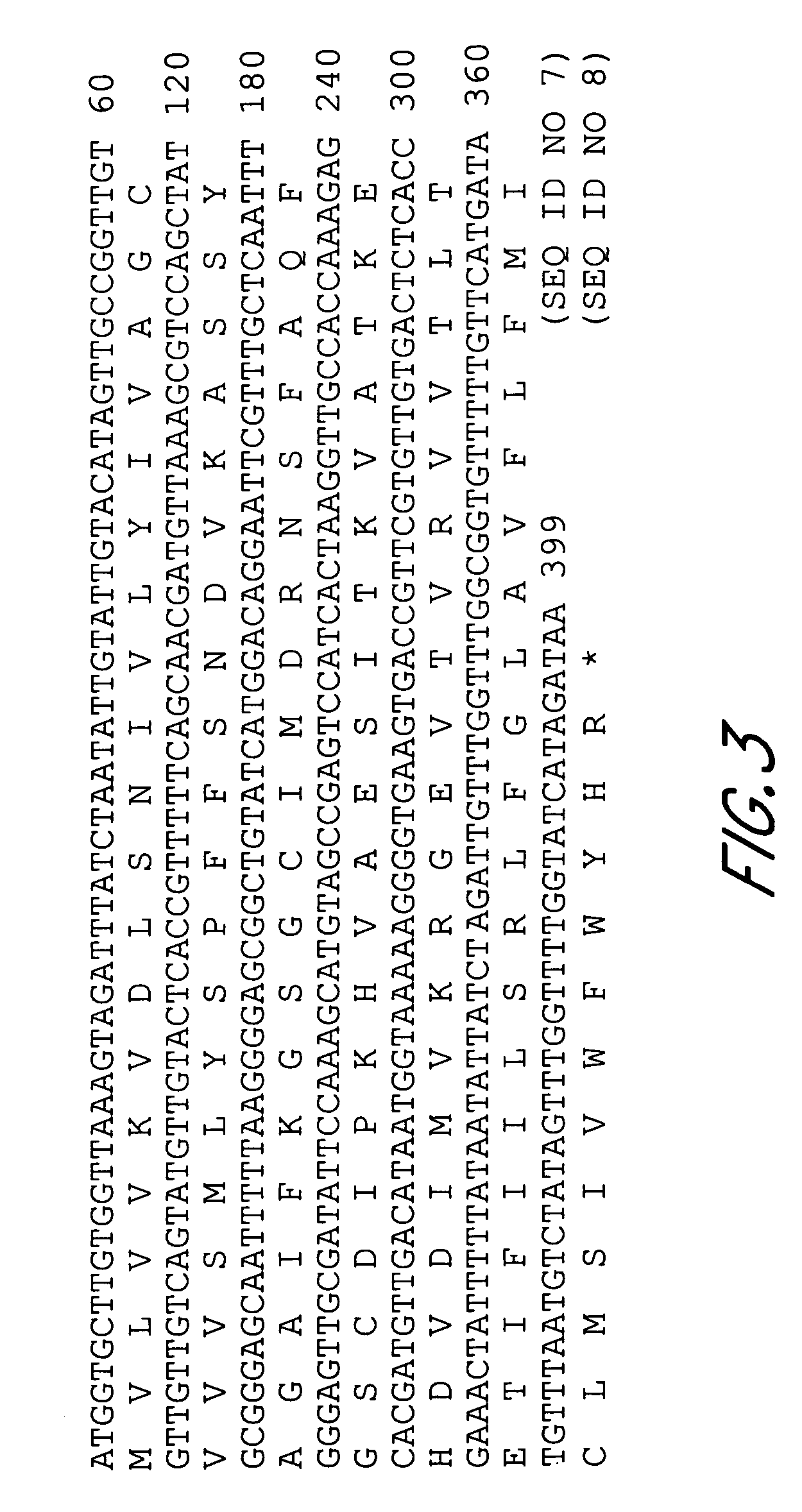P15 hairpin constructs and use
a construct and dna technology, applied in foreign genetic material cells, plant cells, sugar derivatives, etc., can solve the problems of large loss of harvest, deleterious effects of wild type sequences on the agronomic properties of transformed plants or plant cells, etc., to achieve long-term resistance and increase the stability of the rhizomania resistant variety
- Summary
- Abstract
- Description
- Claims
- Application Information
AI Technical Summary
Benefits of technology
Problems solved by technology
Method used
Image
Examples
example 1
Characterization of BNYVV Resistant Transgenic Plants
[0173] Three independent transgenic Beta vulgaris lines were created that express the protein BNP15-Ala4 (encoded by SEQ ID NO 3). Two out of three lines were found resistant to BNYVV.
[0174] P15 protein expression was found to be significantly higher in the susceptible line than in the resistant lines. siRNAs were detected, but only in plants of the BNYVV resistant line (Table 2).
[0175] BNYVV resistance may thus be triggered by PGTS. To further test this hypothesis, one leaf of each line was infected with a viral inoculum (Stras 1234 providing RNA1, RNA2, RNA3 and RNA4). Few to no lesions developed on the leaves of resistant plants that were infected as such, whereas leaves of susceptible plants developed numerous lesions. P15-specific siRNA molecules were detected in plants of the BNYVV resistant lines, yet not in any of the susceptible plants.
[0176] No modification in the p15 gene sequence or in the sequence of the transcrip...
example 2
P15 Hairpin Constructs
[0177] To study the functionality of the PTGS inducing (mutated) P15 sequence, a binary Agrobacterium vector was constructed containing a genetically modified P15 gene (e.g., (a modified) SEQ ID NO 3) in sense and antisense orientation, interspersed by a petunia intron or a sugar beet intron.
[0178] Below the results obtained with three hp15 constructs (see FIGS. 4, 5) are given. The intronic sequence in construct 1 is derived from petunia (see FIG. 4), whereas the intronic sequence in constructs 2 and 3 is derived from beet. Constructs 2 and 3 differ in length of the intron only: 550 nt in the case of the pS140 vector and 91 nt only in the case of the pS142 vector (FIGS. 5A and B respectively).
[0179] The creation of the DNA constructs according to the invention and the cloning of these constructs into Agrobacterium tumefaciens (e.g. a (disarmed) GV3101 strain) was performed according to methods and techniques well known in the art. The p15 sense and antisens...
example 3
Experimental Protocols
[0181] Leaf material of Tetragonia expensa, Beta macrocarpa and Beta vulgaris (plants sustaining BNYVV artificial leaf inoculation) was agro-infiltrated followed by an infection of BNYVV (Stras 1234 or Stras 12 (providing RNA1 and RNA2). For the protocols, see below and for the constructs, see above.
[0182] The Agrobacterium tumefaciens carrying a hairpin construct is grown up overnight at 28° C. The cells are pelleted by centrifugation (15 min at 5000 g) and resuspended in 10 mM MgCl2 buffer containing acetosyringone (200 μM) and the OD600 nm adjusted to 1. The cell suspension is kept at room temperature for 3 h before infiltration.
[0183] Agro-infiltration is performed by injecting the Agrobacterium solution into leaves of seedlings (of e.g. Beta macrocarpa, Beta vulgaris, Tertragonia expansa, Nicotiana benthamina, Chenopodium quinoa) at the 4 leaf stage. A 2 ml needle-less syringe, is pressed on the upper side of a needle-wounded leaf. Each leaf, except the...
PUM
| Property | Measurement | Unit |
|---|---|---|
| pH | aaaaa | aaaaa |
| diameter | aaaaa | aaaaa |
| diameter | aaaaa | aaaaa |
Abstract
Description
Claims
Application Information
 Login to View More
Login to View More - R&D
- Intellectual Property
- Life Sciences
- Materials
- Tech Scout
- Unparalleled Data Quality
- Higher Quality Content
- 60% Fewer Hallucinations
Browse by: Latest US Patents, China's latest patents, Technical Efficacy Thesaurus, Application Domain, Technology Topic, Popular Technical Reports.
© 2025 PatSnap. All rights reserved.Legal|Privacy policy|Modern Slavery Act Transparency Statement|Sitemap|About US| Contact US: help@patsnap.com



